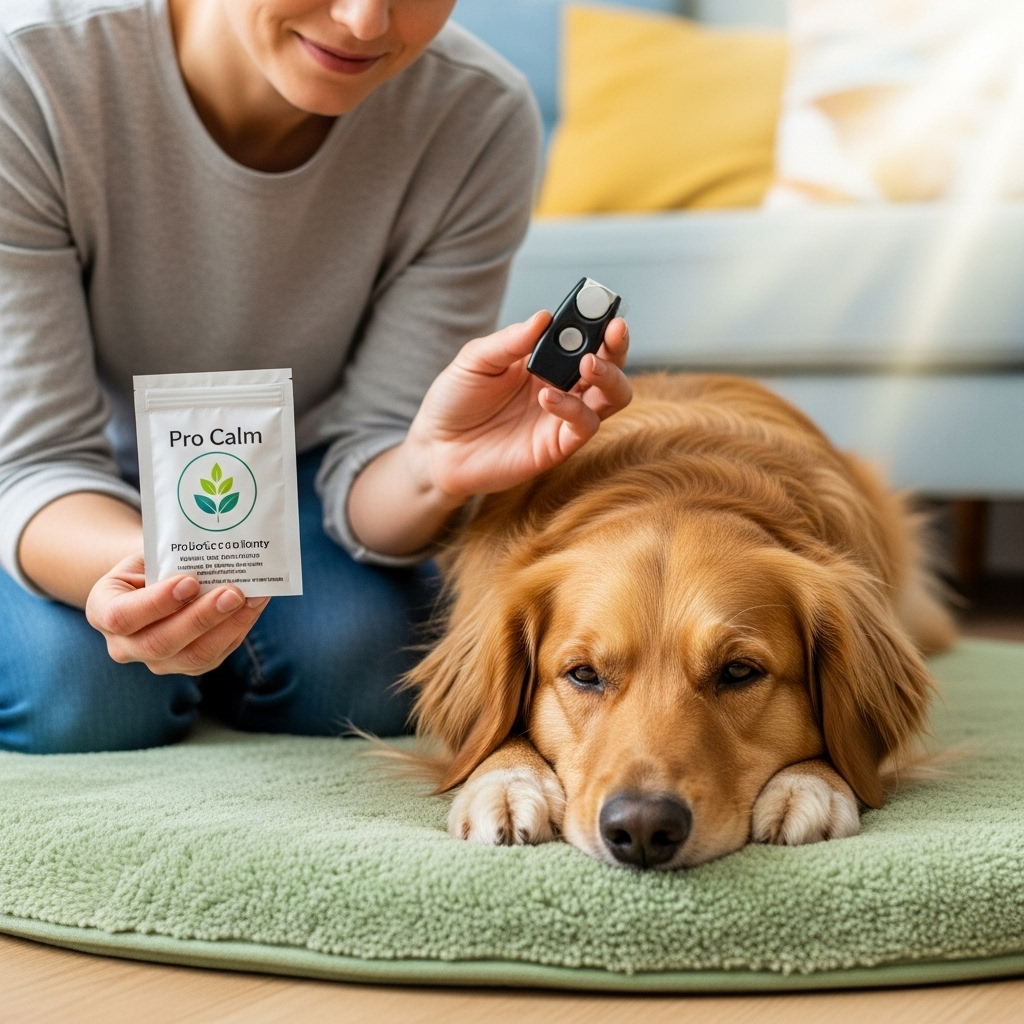Calming Probiotics for Anxious Dogs: What to Expect

If your dog shows signs of anxiety — pacing, trembling, destructive behavior, or clinginess — you may have heard that probiotics can help. “Calming probiotics” are formulated to support the gut-brain axis and may reduce stress-related symptoms in some dogs when used alongside training and environmental management. This article explains how these products work, what evidence exists, how to pick and use them safely, and what realistic results you can expect.
How calming probiotics are supposed to work
The idea behind calming probiotics is that a healthy gut microbiome influences the nervous system and emotional state through several biological routes. These include:
- Production of microbial metabolites (for example, certain short-chain fatty acids) that affect brain signaling.
- Modulation of the immune system and inflammation, which can affect mood and stress responses.
- Communication along the vagus nerve between the gut and brain and changes in neurotransmitter availability (some microbes can influence GABA and serotonin pathways).
Because of these links, adjusting gut bacteria with targeted probiotic strains may support calmer behavior in some dogs, particularly when anxiety relates to stress or gut discomfort. However, probiotics are not a replacement for behavior modification, training, or veterinary care for severe anxiety.
Which probiotic strains show promise for anxiety and stress
Research into specific strains and behavioral outcomes is still developing, but some microorganisms commonly used in canine calming formulas include:
- Lactobacillus species — certain strains have been studied for stress-related behavior in animals.
- Bifidobacterium species — implicated in gut barrier and immune support, sometimes associated with mood benefits.
- Enterococcus faecium — widely used in pet probiotics for general gut health; some formulations combine it with other calming strains.
- Saccharomyces boulardii — a beneficial yeast that supports gut balance during stress, especially when antibiotics are involved.
Manufacturers may include additional ingredients such as prebiotics, L-tryptophan, chamomile extracts, or L-theanine to enhance calming effects. Evidence for these adjuncts varies; look for products backed by published studies or clinical trials in dogs when possible.
Choosing a quality calming probiotic
Consider these factors when selecting a product:
- Strain specificity: Choose products that list specific strains (e.g., Lactobacillus rhamnosus GG) rather than only genus names. Different strains have different effects.
- CFU count and stability: Look for guaranteed colony-forming units (CFUs) through the end of shelf life and appropriate storage instructions (some require refrigeration while others are shelf-stable).
- Formulation for dogs: Human probiotics can be different in composition and dosing. Use products formulated for pets or recommended by a veterinarian.
- Transparency and testing: Reputable brands will provide manufacturing quality control information and may show third-party testing for purity and potency.
- Delivery format: Chews, powders, capsules, or treats — pick a form your dog will accept and that fits your lifestyle.
How to give probiotics and what to expect
Dosage and timing
Follow the product label or your veterinarian’s instructions for dosing. Doses vary widely between products; many pet probiotics provide from hundreds of millions to tens of billions of CFUs per serving. When your dog is also on antibiotics, give probiotics at least two hours apart from antibiotic doses to improve survival of the probiotic organisms.
How soon will you see changes?
Behavioral or digestive improvements are usually gradual. Some dogs show changes within 2–4 weeks, while others may need 6–12 weeks of consistent use. Combine probiotics with behavior modification, enrichment, and stress-reducing routines for the best chance of improvement.
Safety, side effects, and precautions
Probiotics are generally well tolerated in healthy dogs. Common mild side effects include temporary gas or softer stools during the adjustment period. Rarely, dogs with severely weakened immune systems or those with central venous catheters could be at risk for opportunistic infection from live organisms.
- Stop use and consult your veterinarian if your dog becomes sicker after starting a probiotic.
- Discuss probiotics before use if your dog is immunocompromised, critically ill, or on multiple medications.
- If your dog is on prescription behavioral medications or has a serious anxiety disorder, probiotics should be an adjunct — not a replacement — to veterinary care and behavior therapy.
Pros and Cons
| Pros | Cons |
|---|---|
|
|
When to see your veterinarian
Make an appointment if:
- Anxiety is severe, causing self-injury, aggression, orhousehold disruption.
- Behavioral signs began suddenly or are accompanied by GI signs like ongoing vomiting or diarrhea.
- Your dog has complex medical issues or you want help choosing a veterinarian-endorsed probiotic product and a comprehensive behavior plan.
FAQ
Q: How long before I know if a probiotic is helping my dog’s anxiety?
A: Expect at least 2–4 weeks for initial changes, and up to 8–12 weeks for clearer assessment. Track behavior consistently and combine probiotics with behavior strategies.
Q: Can calming probiotics replace behavioral training or medication?
A: No. Probiotics are an adjunctive tool. Severe or persistent anxiety usually requires training, environmental changes, and sometimes prescription medications under a veterinarian’s guidance.
Q: Are probiotics safe with other medications?
A: Often yes, but always check with your vet. If your dog is on antibiotics, give the probiotic at a different time of day to improve survival of the probiotic organisms.
Q: Can probiotics help noise phobias or storm anxiety?
A: Some dogs may experience reduced stress responses after microbiome support, but results vary. Use probiotics as part of a multi-pronged plan that includes desensitization and counterconditioning.
Key Takeaways
- Calming probiotics aim to support the gut-brain connection and may help some anxious dogs, but results vary.
- Choose products that list specific strains, guaranteed CFUs, and veterinary formulation when possible.
- Expect gradual improvements over weeks; combine probiotics with behavior training and environmental management.
- Probiotics are generally safe but consult your veterinarian for dogs with serious medical issues or severe anxiety.
Disclaimer: This article provides general information and is not a substitute for professional veterinary advice, diagnosis, or treatment. Always consult your veterinarian before starting any new supplement, especially if your dog has health conditions or is taking medications.

Leave a Reply